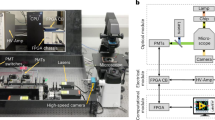Abstract
An ultra-sensitive DNA microspot assay was developed that required 1.8 nL samples and was based on single-molecule detection. The solution of the target DNA (tDNA) was spotted onto the coverslip modified with capture DNA (DNA1) and blocked with ethanolamine and bovine serum albumin using a pintool type microspoting robot. The microspot had a diameter of ~300 μm. The tDNA was captured by the DNA1, and the tDNA was then labeled with a detection DNA that previously was labeled with a quantum dot. Next, a fluorescence microscopic image of the microspot was acquired using a single-molecule microspot reader during total internal reflection fluorescence excitation. As little as 4 × 10−22 mole (240 molecules) of tDNA can be detected by this method. The response is linear in the range from 6.0 × 10−22 to 1.2 × 10−19 mole of tDNA. All operations (including the acquisition of microspot images and single-molecule counting) were performed using the MetaMorph software. The assay was applied to the determination of osteopontin messenger RNA in single decidual stromal cells without the need for PCR amplification.

A DNA microspot assay with a limit of detection of 240 molecules was developed that requires 1.8 nL samples and is based on single-molecule detection. The assay was applied to the determination of osteopontin messenger RNA in single decidual stromal cells without the need for PCR amplification.



Similar content being viewed by others
References
Bentwich I, Avniel A, Karov Y, Aharonov R, Gilad S, Barad O, Barzilai A, Einat P, Einav U, Meiri E, Sharon E, Spector Y, Bentwich Z (2005) Identification of hundreds of conserved and nonconserved human microRNAs. Nat Genet 37:766–770
Levicky R, Horgan A (2005) Physicochemical perspectives on DNA microarray and biosensor technologies. Trends Biotechnol 23:143–149
Draghici S, Khatri P, Eklund AC, Szallasi Z (2006) Reliability and reproducibility issues in DNA microarray measurements. Trends Genet 22:101–109
Hesse J, Jacak J, Kasper M, Regl G, Eichberger T, Winklmayr M, Aberger F, Sonnleitner M, Schlapak R, Howorka S, Muresan L, Frischauf AM, Schutz GJ (2006) RNA expression profiling at the single molecule level. Genome Res 16:1041–1045
Mir KU (2006) Ultrasensitive RNA profiling: counting single molecules on microarrays. Genome Res 16:1195–1197
Nagl S, Schaeferling M, Wolfbeis OS (2005) Fluorescence analysis in microarray technology. Microchim Acta 151:1–21
Duggan DJ, Bittner M, Chen Y, Meltzer P, Trent JM (1999) Expression profiling using cDNA microarrays. Nat Genet 21:10–14
Gerion D, Chen F, Kannan B, Fu A, Parak WJ, Chen DJ, Majumdar A, Alivisatos AP (2003) Room-temperature single-nucleotide polymorphism and multiallele DNA detection using fluorescent nanocrystals and microarrays. Anal Chem 75:4766–4772
Zhou X, Zhou J (2004) Improving the signal sensitivity and photostability of DNA hybridizations on microarrays by using dye-doped core-shell silica nanoparticles. Anal Chem 76:5302–5312
Käppel ND, Dankbar DM, Gauglitz G (2006) DNA quantification in nanoliter volumes. Microchim Acta 154:65–71
Li L, Li X, Li L, Wang J, Jin W (2011) Ultra-sensitive DNA assay based on single-molecule detection coupled with fluorescent quantum dot-labeling and its application to determination of messenger RNA Anal. Chim Acta 685:52–57
Hesse J, Sonnleitner M, Sonnleitner A, Freudenthaler G, Jacak J, Hoglinger O, Schindler H, Schutz GJ (2004) Single-molecule reader for high-throughput bioanalysis. Anal Chem 76:5960–5964
Li L, Qu X, Sun J, Yang M, Song B, Shao Q, Zhang X, Jin W (2011) Single-molecule-counting protein microarray assay with nanoliter samples and its application in the dynamic protein expression of living cells. Biosens Bioelectron 26:3688–3691
Hernandez FH, Escriche JM (1984) Fluorimetric determination of aluminium with morin after extraction with isobutyl methyl ketone. Part I. Fluorescence of the aluminium-morin complex in an isobutyl methyl ketone-ethanol-water system. Analyst 109:1585–1588
Chiang M, Melton DA (2003) Single-cell transcript analysis of pancreas development. Dev Cell 4:383–393
Kamme F, Salunga R, Yu J, Tran D, Zhu J, Luo L, Bittner A, Guo H, Miller N, Wan J, Erlander M (2003) Single-cell microarray analysis in hippocampus CA1: demonstration and validation of cellular heterogeneity. J Neurosci 23:3607–3615
Tietjen I, Rihel JM, Cao YX, Koentges G, Zakhary L, Dulac C (2003) Single-cell transcriptional analysis of neuronal progenitors. Neuron 38:161–175
Wagatsuma A, Sadamoto H, Kitahashi T, Lukowiak K, Urano A, Ito E (2005) Determination of the exact copy numbers of particular mRNAs in a single cell by quantitative real-time RT-PCR. J Exp Biol 208:2389–2398
Zhang X, Sun F, Peng X, Jin W (2007) Quantitative determination of enzyme activity in single cells by scanning microelectrode coupled with a nitrocellulose film-covered microreactor by means of a scanning electrochemical microscope. Anal Chem 79:1256–1261
Acknowledgments
This project was supported by the National Natural Science Foundation of China (Grant Nos. 90713016 and 20975061). We are grateful to Prof. Xun Qu (Institute of Basic Medical Sciences of Qilu Hospital and Key Laboratory of Cardiovascular Proteomics of Shandong Province) for providing DSCs.
Author information
Authors and Affiliations
Corresponding author
Electronic supplementary material
Below is the link to the electronic supplementary material.
ESM 1
(DOC 83 kb)
Rights and permissions
About this article
Cite this article
Sui, B., Li, L., Li, X. et al. DNA microspot assay using single-molecule detection and requiring 1.8 nL samples only. Microchim Acta 174, 201–206 (2011). https://doi.org/10.1007/s00604-011-0640-1
Received:
Accepted:
Published:
Issue Date:
DOI: https://doi.org/10.1007/s00604-011-0640-1




